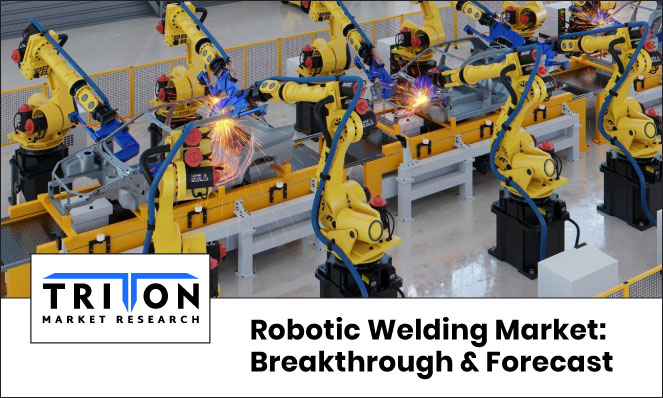



03, November 2022

Automation has disrupted the industrial sector by drastically changing production techniques and reducing the overall time and cost spent. As a result, robotic welding technology is becoming increasingly popular across automotive, metal & machinery, electronics, and other industries. According to the experts at Triton Market Research, the Global Robotic Welding Market will advance with a CAGR of 7.35% over the forecast period, 2022-2028.
Welding robots can perform complicated tasks and provide superior output quicker than human workers. They are developed by combining welding, robotics, artificial intelligence, control systems, and sensor technology. These robots’ operational excellence, along with increased productivity, contribute to their demand.
Industry 4.0 has revolutionized the manufacturing sector by equipping it with advanced technology, thus leading to enhanced productivity, flexibility, quality, and speed. Manufacturers are now shifting towards the adoption of intelligent and networked Industry 4.0-compatible robots incorporated with wireless connectivity, sensors, and a centralized control system.
Additionally, players in the robotic welding market are also focusing on introducing such solutions to the market. For instance, in March 2020, Roboteco Italargon developed a robotic welding cell for its client Steel Tech, to increase production and ensure interconnection within all stages of the manufacturing process. The cell is comprised of a TIG arc welding solution and an Industry 4.0 kit to enable easy data exchange for efficient interconnection.
The automotive & transportation sector is the leading industry vertical in the robotic welding market, which accounted for the highest revenue share of $4172.27 million in the segment in 2021.
The rising demand for vehicles and efficient infrastructure has compelled the automotive & transportation sector to enhance production and construction activities. Being at the forefront of embracing technological innovations, it has largely adopted robotic welding arms to boost the accuracy and speed of the vehicle-building process. In fact, from 2018 to 2023, the use of welding robots in this sector increased with a CAGR of 8.91%.
The Asia-Pacific robotic welding market is the leading region globally. It accounted for $8767.11 million in 2021 and is estimated to gain $7985.35 million by 2028.
According to the International Federation of Robotics (IFR) , Asia accounted for 71% of all newly deployed industrial robots in 2020, with 168,400 units installed in China itself. Moreover, India, China, Japan, and South Korea are among the leading automobile manufacturers in the world. The presence of a robust automotive industry has enhanced the adoption of welding robots in the Asia-Pacific.
Besides, Japan is home to several leading market players, including Yaskawa Electric Corp, Hyundai Motor, Nachi-Fujikoshi Corp, Kawasaki Heavy Industries Ltd, and others, which are focused on devising growth-driven strategies. For instance, in March 2022, Nachi-Fujikoshi Corp launched its MZ F series comprising high-speed and high-precision robots, driven by the need to tackle labor shortage.
Further, in July 2022, Daihen Corporation developed a new welding arc called Plasma Jet TIG, which is optimal for joining main components such as stator coils of motors used in electric vehicles. Also, in August 2022, Yaskawa Electric Corp launched its new lineup of Motoman-HC30PL welding robots, with a 30 kg payload capacity for palletizing applications.
Along with these factors, the implementation of major manufacturing initiatives such as ‘Made in China 2025’ and ‘Make in India’ is expected to aid the adoption of robotic welding systems, thus positioning the region’s market on a growth path.
Currently, operators are required to program welding robots before deploying them for a process. However, with advancements in technology, they may only need to think about the desired task to be performed by the robot. In February 2019, researchers at the University of Illinois Urbana-Champaign developed an EEG-based cap that converts brain waves into operational instructions for robotic welding arms.
If used for industrial applications, this breakthrough development could eliminate the need for computer programming and also reduce the time taken for training the personnel. Though the complete development and adoption of such mind-controlled robots may still take several years, it creates positive prospects for the future of the global robotic welding market.
North America is expected to grow the fastest in the global market, with a CAGR of 8.99% during the forecast period.
Q 2) Which are the different types of welding covered in the market report?The global robotic welding market by welding type includes spot, plasma, arc (TIG, MIG), laser, and other welding types.
Q 3) What is a key challenge in the path of market growth?The high costs for installing and maintaining welding robots are a key market challenge hindering their adoption.

Prevalent cases of terrorist attacks in today’s world is increasing the need for severe standards of security for public safety, and the global market for biometric technology scrupulously accommoda..
Prevalent cases of terrorist attacks in today’s world is increasing the need for..